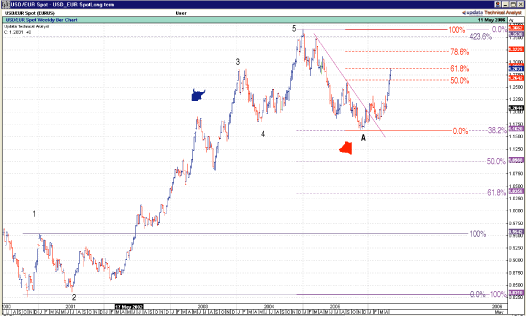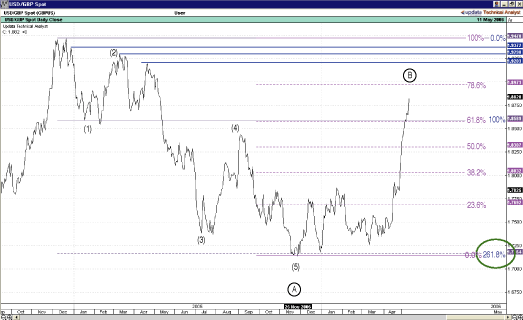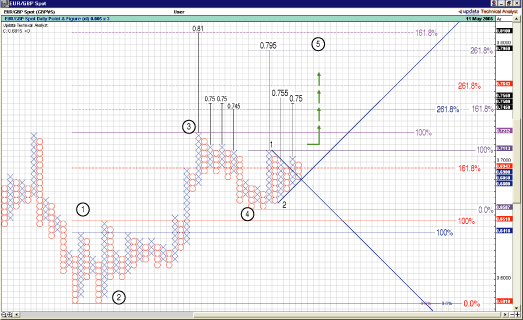Access to foreign exchange trading has opened up exciting trading options for the retail trader. You can now trade alongside corporations and institutions in a highly liquid market that is global, traded around the clock, and highly leveraged. Before jumping into this market, however, we must understand the factors that affect the forex market. With that in mind, STOCKS& COMMODITIES has introduced Forex Focus to better prepare the retail trader to participate in the currency market.
What do Fibonacci levels and currencies have in common? More than you would think. Take a look.
Since reporting on the euro/US dollar (EUR/USD) and the British pound/US dollar (GBP/USD) in December 2005 I have maintained they are in long-term downtrends, and the recent market movements of the past six months have been, and may continue to be in the short term, in a corrective phase. Further, the dollar reached the depths of its depreciation against the euro and sterling throughout the 2000-04 period. I also contended that the new peak in these markets would occur when least expected — when the press and media would headline the drop of the dollar again and refer back to the US current account deficit arguments — as occurred in December 2004. Key price targets were given as potential turning points, and it is unsurprising that the media has once again picked up on the current account argument when the British/pound/US dollar (GBP/USD) has hit 61.8% and the euro/US dollar (EUR/USD) has hit the 50% retracement levels over the last 10 days.
Meanwhile, other targets (61.8% and 78.2% Fibonacci levels) are still in play, and the closer the price gets to them, the more difficult it becomes to remain bearish on the charts (bullish on the dollar) and the more tempting it is to lose patience and change camps, particularly when faced with news media headlines such as:
- "Dollar starts the big slide against major currencies" —Sunday Times of London, April 30, 2006
- "Pause for thought as dollar slump…" —Evening Standard (London), May 3, 2006
- "ECB silence allows euro to climb against ailing dollar" —Financial Times, May 6-7, 2006
- "Euro’s rise is linked to good news this time" —International Herald Tribune, May 9, 2006
EUR/USD
One of the most profitable charts in the foreign exchange markets has been the EUR/USD (Figure 1). Fibonacci numbers are at work and the resultant patterns and ratios have been as close to textbook examples as we are ever likely to find. Similarly, the GBP/USD chart has also been profitable, particularly over the past year.

FIGURE 1: EUR/USD. Key price levels on the upside: 1.2849, 1.2883, 1.3169, 1.3225.GBP/USD
Much like the EUR/USD chart, the Elliott waves can be spotted on GBP/USD in Figure 2. Although the price targets given have all been on the upside, they should be perceived as potential medium-term peaks. Price targets on the downside will be estimated once the pattern forms over the weeks and months ahead.

FIGURE 2: GBP/USD. Key price levels/turning points (approximate): 1.857, 1.869, 1.890, 1.897, 1.890, 1.929, 1.901.
Though we are faced with repeated warnings of unsustainable US current account deficits, it is worth noting that policy mixes affect the value of a currency. A restrictive monetary policy (that is, an interest rate above the neutral rate) coupled with an expansionary fiscal policy, should that scenario develop, is a recipe for an appreciation of the currency according to the widely respected Mundell-Fleming model. This scenario cannot be easily dismissed, as it is still feasible that interest rates may rise and fiscal deficits are unlikely to be reversed.
EUR/GBP
The European Central Bank (ECB) has an "accommodative monetary policy stance," with low nominal interest rates stimulating the current high trend of monetary expansion. The ECB clearly identifies the risks to prices over both the medium and long run, and it has been adamant in anchoring prices and stopping these risks from materializing. The greatest price risks include house prices and oil prices.
To maintain price stability and control the risks of higher prices, the ECB is likely to increase interest rates over the medium run. Extremely low rates, combined with the fact that the ECB was the last of the three major western central banks to start their cycle of interest rate rises, indicate that further increases by the ECB should be expected. This, coupled with the general consensus that the Bank of England has at least paused in their cycle for the short/medium run, may provide the fundamental basis for a change in EUR/GBP, away from a generally sideways moving market to one of euro strength. Price target convergences of Fibonacci extensions and point & figure counts bring confidence to the projections/targets (Figure 3).

FIGURE 3: EUR/GBP. Long-term price targets (for wave 5 peak): 0.745, 0.75, 0.755, 0.795, 0.81.
Both the fundamental and technical arguments given here indicate that the dollar should strengthen against the euro and the pound. Both analyses provide ammunition against the prevailing media consensus that the dollar should and will fall. The strength and relevance of the fundamental arguments made by the press, particularly those centered on the US current account deficit, are unclear. Further, they have not provided solid explanations, let alone forecasts, for the behavior of the dollar over the long term. Elliott wave patterns could, however, have been observed over six months ago and provided significant forecasting ability. Though the US does have the problem of a large, and perhaps unsustainable, trade deficit, a falling dollar against the euro and/or the pound is unlikely to be the solution over the medium term.
Shyam Devani is an independent market analyst in London. He may be reached at sgdevani@yahoo.co.uk.
- Updata Technical Analyst
Originally published in the July 2006 issue of Technical Analysis
of STOCKS & COMMODITIES magazine. All rights reserved.
© Copyright 2006, Technical Analysis, Inc.